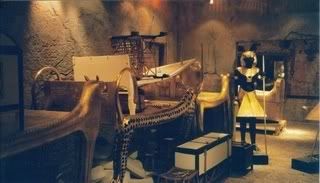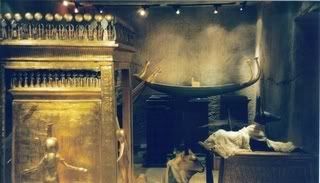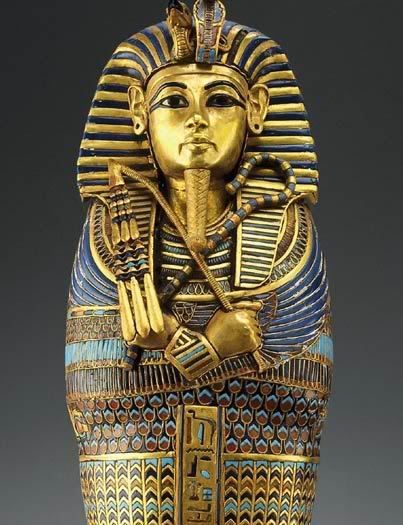 [Above *Figure 1* - Replica of the antechamber from Tutankhamun's tomb upon discovery. Photo from the Luxor Hotel, Las Vegas, NV. Supplied by Michael Lamberth.]
[Above *Figure 1* - Replica of the antechamber from Tutankhamun's tomb upon discovery. Photo from the Luxor Hotel, Las Vegas, NV. Supplied by Michael Lamberth.]
The tomb was likely originally constructed as a private tomb of a noble or official of the 18th dynasty, but was abandoned undecorated. This is suspected, as it has a similar style to the Amarna Cache (KV55) and the tomb of Yuya and Tjuiu (KV46). Private tombs of the New Kingdom traditionally opened up directly into a chamber via a stairway and corridor, like in the case of KV62. The only parts of the tomb which appear to be part of the original cutting, are the sloping entry passage and the antechamber, which in its non-royal state would have served as a burial chamber itself. The annexe, burial chamber, and treasury are thought to have been added later, and in the case of the burial chamber and treasury, were possibly only added after Tutankhamun's death. On the ceiling of the tomb, between the antechamber and the burial chamber, is an apparent edge from the original digging of the tomb. This area was later re-cut, and can be observed by the rougher chisel marks, which make obvious the expansion into the burial chamber and beyond. KV62 is 30.79 meters in length with a total area of 109.83 meters squared. Its style is very basic with a sloping corridor leading to the antechamber, with the annexe situated ahead of this chamber on the left-hand side. To the right of the antechamber is the burial chamber, which is set a meter lower than the previous chambers, and leading off from the burial chamber - turning right again - at the same level as the burial chamber, is the treasury.
Because KV62 had been sealed shut for over 3,000 years, it had retained its artwork in very good condition apart from some damage from damp within the tomb. In the case of this tomb, though, it was only the burial chamber which was decorated, and it was only in the style of paint on plaster. On the west wall (left wall upon entering the chamber) a scene from the First hour of the Amduat is depicted by painted apes. The North wall (the wall ahead when entering the chamber) depicts a few different scenes. Firstly, Tutankhamun is shown in the company of the goddess, Nut, and then further along the wall he is depicted with Usir [Osiris] and his own ka. The scene of the most interest along this wall, however, is a scene from the Opening of the Mouth ceremony, but the ceremony isn't performed by a priest - as was the tradition in ancient Egypt - but by Tutankhamun's successor, King Aye, whom is named in this scene, and is wearing the attire of a priest; a leopard skin cape. Aye's cartouche here is also unique, as it is unknown for a king to have his successor's name printed in his own tomb. It seems that this last ceremony that was performed for Tutankhamun had been used by Aye to help to justify his claim to the throne, as there may well have been questions as to whom should succeed Tutankhamun's short reign. On the east wall (wall to the right upon entering the chamber) is another scene which is unusual amongst royal tomb wall decoration - although, it was often seen in private tombs - in that it depicts part of the funeral procession. This comes from Chapter one in the Book of Coming Forth by Day, and shows Tutankhamun's mummy being pulled along on a sledge through the necropolis. The southern wall, on the left side of the doorway from the antechamber when entering the burial chamber, there is a depiction of Inpu [Anubis] introducing Tutankhamun to Hut-Hor-Imenet [Hathor, Lady of the West]. On the right-hand side of this same doorway was once a scene showing Tutankhamun being welcomed into the afterlife by Inpu, Hut-Hor, and Aset [Isis], but the figure of Aset was destroyed by Carter's team when they had to knock down more of the wall to removed the shrines during excavation.
 [Above *Figure 2* - Replica of the treasury from Tutankhamun's tomb upon discovery. Photo from the Luxor Hotel, Las Vegas, NV. Supplied by Michael Lamberth.]
[Above *Figure 2* - Replica of the treasury from Tutankhamun's tomb upon discovery. Photo from the Luxor Hotel, Las Vegas, NV. Supplied by Michael Lamberth.]
 [Right *Figure 3* - Chest with carrying poles from the tomb of Tutankhamun, depicting scenes from the Opening of the Mouth ceremony. Photo supplied by John DeWerd.]
[Right *Figure 3* - Chest with carrying poles from the tomb of Tutankhamun, depicting scenes from the Opening of the Mouth ceremony. Photo supplied by John DeWerd.]Two suspected daughters of Tutankhamun were also discovered in the treasury inside miniature coffins of their own. They were both stillborn, but had both been mummified. Some ritual objects in KV62 were initially made for various ancestors of Tutankhamun, and were either removed from storage as surplus materials to add to Tutankhamun’s funerary equipment, commandeered from a former king’s possessions, or simply heirlooms or gifts that were bestowed upon Tutankhamun. One such heirloom discovered in KV62 was a lock of hair belonging to Queen Tiyi (his Grandmother), inside four nested miniature coffins. Many chests were also found in his tomb [figure 3 being an example of one], containing vast amounts of jewellery as well as kiosks containing ushabtis. A massive 413 ushabtis were discovered throughout the tomb, made from various materials, including wood, clay, and faïence. Among the many other ritualistic artefacts that were recovered from the treasury were model boats [shown in figure 2 depicting the treasury - background] that the pharaoh would have used symbolically to journey to the afterlife in.
Inside the burial chamber Tutankhamun was buried in a series of three anthropoid coffins nested inside each other, with the innermost one being made from solid gold, and the other two wooden with golden inlays. The coffins were stood upon a bier inside a quartzite sarcophagus which was enclosed with a broken red granite lid. Surrounding the sarcophagus was three gilded wooden shrines, one inside the other, which was then followed by a wooden pall stand with a linen covering over it. Beyond that was a fourth, and final, shrine. Many different artefacts were discovered between the shrines and around the outside of the outermost shrine on the floor; such as statues and archery equipment. Tutankhamun had been mummified and had been provided with numerous amulets, collars, pectorals, and bangles which had been wrapped inside his mummy bandaging. He then had copious amounts of resin poured over him - avoiding the feet and head - as well as having his golden funerary mask placed over his head, and floral wreaths adorned him and his coffin.

[Left *Figure 4* - Tutankhamun's miniature coffin that held his liver inside his alabaster canopic chest, and contains a recitation to Aset (protector of Imsety) inscribed down the centre front. Photo supplied by John DeWerd.]
The broken miss-matched sarcophagus lid that had been painted to try to match the rest of the sarcophagus, and the mixed styles of the artwork in the tomb, lead us to suspect that the funerary equipment was put together haphazardly and rushed, but what lends even more to this theory, are the oval shaped meat boxes that were discovered in the antechamber. These boxes obviously should not have been in this room, as all other 'offerings' of this kind were stored in the annexe, and it seems very unlikely that they would have been relocated here for any reason. When the tomb was discovered, the annexe was in the worse condition, with artefacts broken and thrown about by tomb robbers. The first things to be looted by robbers tended to be items that had a very short shelf-life, which explains why this room was badly ravaged by the robbers, as they drained out all oils and wines from their jars stored in this room, discarding empty jars aside. Intrestingly, some of these jars have been found to still have the fingerprints left on them from the long ago robbers. Baskets of fruits were also stored in the annexe along with many other offerings.
The antechamber [figure1 pictured bove] was the first chamber you viewed upon entering the tomb. Along the west wall (ahead upon entering the chamber) funiture, including chairs, beds, chests, and other miscellaneous items were stacked high. Three ritual beds were lined up along this wall, with the one to the left being made to represent a composite creature - possibly Ammit - being part hippopotamus, part crocodile, and part leopard. The centre bed was in the form of Hut-Hor; being depicted as a cow wearing the sun disc between the horns. And the one to the right was in the guise of a lion; all three of the beds being made from gold covered wood. Beneath the left-hand bed was Tutankhamun's golden throne, which contained scenes dedicated to the Aten cult along with the titles of Tutankhamun and Ankhesenamun from the Amun cult, showing that this chair may have been constructed during a transitional period between both these religious practices. On the reverse side of the throne's backrest is a scene of birds in a thicket, whilst the front of the backrest displays the young king being anointed by his wife. On the front of each armrest is a carving of a leopard's head. Amongst the many artefacts discovered in this chamber were numerous chests which had been labelled in ancient times with their contents. However, when opening these boxes upon discvery, it was often found that the labels did not match the mixture of items that were inside. Because of this, it is often speculated that after each of the tomb robbings that occurred (both not long after the initial interrment of the king), necropolis officials were sent into the tomb to tidy up, and so these officials packed away the objects that were scattered on the floor into any open chest that they came across; hence, many items in this chamber got moved from their original settings. In the south-east corner of the antechamber, four complete, yet dismantled, chariots were piled up (two more were in the treasury), which were made from gold gilded wood. Another important artefact in this chamber were the pair of lifesize ka statues (made to symbolise Tutankhamun's soul) which stood along the north wall guarding the enterance to the burial chamber and beyond. Both statues stand around five foot and six inches tall, made from wood that has been covered in a black resin to represent the black fertile Nile silt. They are both depicted wearing pleated kilts, headdresses, menet collars, pectorals, bangles, and holding a staff and mace which were all gilded with gold. Bronze gilding was also used on these statues to depict the uraeus upon their brow, their sandals, and their make-up. The biggest difference between the pair was their headdress; one was wearing the khat headdress which was often shown on nobility [can be seen in the background on the right-hand side in figure 1], and the other was wearing the nemes headdress which was a linen striped cloth denoting royalty.
When Carter discovered the tomb, the sloping passageway at the enterance had been filled to the ceiling with rock and debris, which he concluded was likely the chippings that had been made whilst the ancient Egyptians were diggig the tomb. A tunnel had obviously been cut in the top left-hand corner of this passageway by tomb robbers, as the dark flint that had been used to fill up the tomb robber's path in the corner stood out from the dusty white chip that filled the rest of the corridor. This proved beyond a doubt that the tomb had been entered into on possibly two occasions after the king had been buried there, and had been later re-sealed by officials [seal shown below].
Considering that Tutankhamun's tomb is one of the smallest royal tombs in the Valley, KV62 is one of the most famous tombs and one of the best documented ever.
________________________________________________________


4 comments:
Tutankhamun's tomb is surely one of the most beautiful ever found. However, I still don't get it why the contents of the tomb seems to be arranged in the wrong order? Do you really think someone broke in and had to hurry up on their way out?
However, Howard Carter granted lots of credit for finding the Tomb of Tutankhamun, you can take a look at this movie that documented this part of his life.
http://egyptgift.blogspot.com/2010/01/search-of-tutankhamun-movie.html
That is informative weblog Thank you. There is useful article about KV 43 at KV43, The tomb of Tuthmosis IV
Egypt is secret country.
Zolpidem
Post a Comment